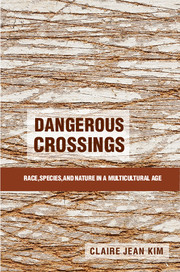Book contents
- Frontmatter
- Dedication
- Contents
- List of Figures and Tables
- Acknowledgments
- Part I Taxonomies of Power
- Part II The Battle over Live Animal Markets in San Francisco’s Chinatown
- 3 The Optic of Cruelty
- 4 The Optic of Racism
- 5 The Optic of Ecological Harm
- 6 Vision/Critique/Avowal
- Part III Other Disputes
- Part IV Conclusion
- References
- Index
4 - The Optic of Racism
Mobilizing the Chinese American Community
Published online by Cambridge University Press: 05 April 2015
- Frontmatter
- Dedication
- Contents
- List of Figures and Tables
- Acknowledgments
- Part I Taxonomies of Power
- Part II The Battle over Live Animal Markets in San Francisco’s Chinatown
- 3 The Optic of Cruelty
- 4 The Optic of Racism
- 5 The Optic of Ecological Harm
- 6 Vision/Critique/Avowal
- Part III Other Disputes
- Part IV Conclusion
- References
- Index
Summary
When you target just Chinese merchants, you have to be out of your mind not to see it is racially motivated.
– Supervisor Leland YeeThe live animal market conflict emerged just as the Chinese American community in San Francisco was reaching for meaningful political power. A significant presence in the city for a century and a half, the Chinese community survived the Exclusion era (1882–1943) to be reinvigorated by post-1965 waves of immigration from throughout the Chinese diaspora. Global political and economic developments powerfully influenced Chinatown and Chinese San Francisco more broadly during this period, shaping the flow and composition of migration as well as the circulation of capital and goods (including animals and animal parts). By the mid-1990s, Chinese San Francisco was vibrant, diverse, and complex, fractured by class, national origin, language, and politics even as it was stitched together by an enduring identification as a distinct cultural and racial group. With dramatic population growth and dispersal beyond Chinatown into the far reaches of San Francisco, Chinese Americans made significant gains in terms of political representation at both the local and state levels, securing the ultimate prize of the mayor’s office in 2011.
The live animal market campaign was one of several issues Chinese American leaders used during the late 1990s and early 2000s to build community or mobilize their fractious population into a reliable political base. Advancing the optic of racism – uniquely resonant in San Francisco because of its distinctive history of anti-Chinese persecution – Chinese leaders argued that the animal campaign was racially motivated and thus threatening not only to Chinese live animal vendors and Chinatown residents but to all Chinese Americans throughout the Bay Area and indeed the nation. The appropriate response, they insisted, was community mobilization, self-defense, and empowerment – that is, to circle the wagons around the live animal vendors and understand that what happened to them happened to the whole Chinese American community. Intent on casting the vendors as innocent victims of racism, Chinese American activists openly declared their belief in human supremacy and peremptorily dismissed the issue of animal cruelty. The optic of racism cast shadows even as it illuminated.
- Type
- Chapter
- Information
- Dangerous CrossingsRace, Species, and Nature in a Multicultural Age, pp. 101 - 139Publisher: Cambridge University PressPrint publication year: 2015

